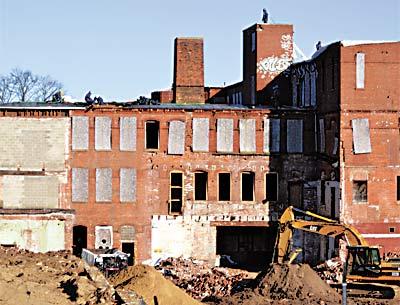$60 Million Makeover Under Way

Reconstruction has begun on Sag Harbor’s crumbling 19th-century Bulova watch factory. The factory, on a 2.3-acre parcel facing Division Street, with its broken and boarded-up windows, is to become a “luxury” condominium complex. The conversion, estimated to cost $60 million, is likely to be the biggest construction project the village has ever seen.
Plans include 65 living units, a fitness center, a swimming pool, dining areas, courtyards, and an underground parking garage. Sixteen of the units will be in seven new town houses adjacent to the historic building. The work is expected to take between 18 months and two years.
Cape Advisors, which has taken on the project, plans to retain the character and architectural detail of the building. The firm is no stranger to large-scale projects, having developed several hotels in New Jersey and the Mondrian Hotel in New York City. Its investment was made possible by a partnership with Deutsche Bank, announced in the fall, after the owners had been challenged to find a construction loan due to the credit market halt. On Oct. 25, Cape Advisors paid the Village of Sag Harbor just over $200,000 for its initial building permit, and the property is now alive with activity.
The factory dates to 1881, when Joseph Fahys built it to make watchcases. One-hundred years later, after it had long been the Bulova watch factory, it was cited for having released semi-volatile organic compounds and heavy metals into the soil and groundwater. It was listed as a state Superfund site, and Bulova was required to do remediation.
Cleanup responsibility was included in Cape Advisors’ agreement to purchase the property from Patrick Malloy III. “The developer is required to install the mitigation measures before the development is occupied. We expect that they will occur at the same time as the development is constructed,” Lisa King of the State Department of Environmental Conservation said on Tuesday. Engineering controls will be required to prevent the intrusion of vapors from the ground into residential areas, and certain restrictions will apply, such as a prohibition of vegetable gardens.
In addition to financing problems, the reconstruction was delayed by controversy over how the developer would meet a Suffolk County requirement that a certain number of units be affordable. Eventually, Cape Advisors agreed to put more than $2.5 million into the village’s Community Housing Trust. The money is guaranteed by a covenant that would apply to any subsequent owner of the property. A payment schedule includes $582,500 in five equal installments prior to, or at the closing of, the sale of the first five units.
Sag Harbor Mayor Brian Gilbride has said the housing trust will work closely with the Long Island Housing Partnership to implement affordable housing in the village, once the necessary funds are received. A panel including planning board members and representatives of Sag Development Partners is to keep tabs on the construction to assure the safety and well-being of residents.
The disruption of parking during construction now seems to be the village’s biggest concern. Parking will be prohibited on Washington Street, from Church Street to Division Street, and Church and Sage have become one-way streets.
At Tuesday’s village board meeting, Larry Perrine, a member of the planning board acting as liaison and speaking on behalf of “people who work, shop, and own businesses in the area,” called the “serious limitation of parking” on Washington Street a cause of concern. Mayor Gilbride said the village would monitor the situation. He shared the idea of limiting parking in the nearby village parking lot to two hours. Mr. Perrine noted that there had not been any restrictions enforced on Washington Street in December or so far in January. The board then came up with a compromise, allowing parking on Washington Street from Church to Division Streets on weekends. The resolution passed unanimously.
Laura Grenning, who owns a nearby building on Division Street, which contains the Grenning Gallery and her residence, said on Monday that she was thrilled at the activity. “The pile drivers and bricks flying is music to my ears,” she said. Ms. Grenning bought her building four years ago in anticipation of the condominium conversion. In her opinion, Washington Street will soon be an added area of activity, with its art galleries and home furnishing stores a new anchor for a thriving year-round village. Of the community at large, she said, “The hope and positive energy in town is palpable.”
It is apparent that many residents are pleased that the factory, which employed 100 people during its heyday as the industrial heart of the village, will have a 21st-century makeover.
County Legislator Jay Schneiderman, whose office is on Washington Street, just steps away from the construction, is among them. He said he had had concerns about safety as the structure deteriorated. He now shares concerns about parking. His staff and guests have difficulty finding spots even now, he said, adding that he often has to move his car every two hours. Over all, however, he said he was pleased. “It had to happen, it has been an eyesore for a long time.”
